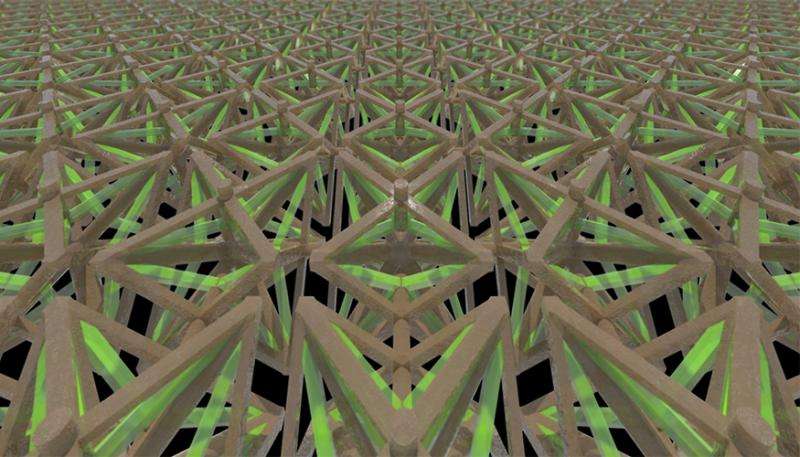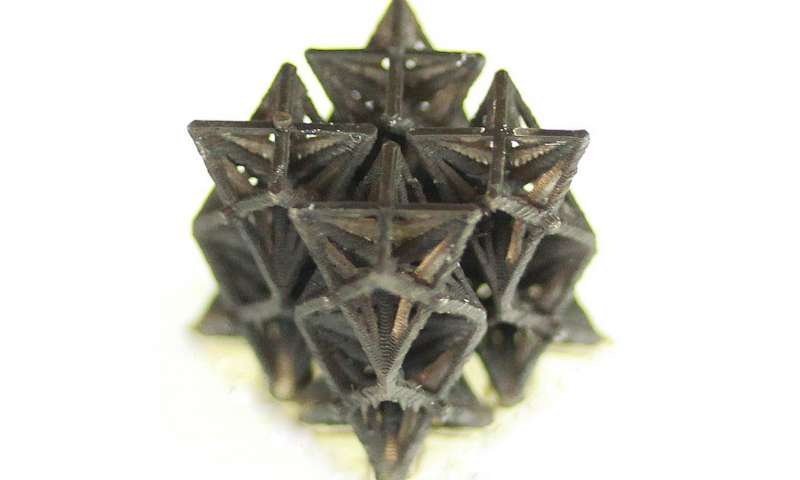LLNL Uses 3D Printing & Lightweight Metamaterials to Solve Thermal Mismatch Issues
 While you might be thinking you’ve heard it all when it comes to 3D printing, it’s generally a good idea to wait a few hours and check back with us, as you’ll probably have to think on that again. And when you see news emerging from Lawrence Livermore National Laboratory (LLNL), you can generally rest assured that whatever innovation they deign to let us in on is going to be something you certainly did not expect. In the past we’ve seen many projects from the California-based lab, from graphene bio-ink allowing for the creation of new microarchitectures to exploring the use of both 4D printing and origami to explore complex structures.
While you might be thinking you’ve heard it all when it comes to 3D printing, it’s generally a good idea to wait a few hours and check back with us, as you’ll probably have to think on that again. And when you see news emerging from Lawrence Livermore National Laboratory (LLNL), you can generally rest assured that whatever innovation they deign to let us in on is going to be something you certainly did not expect. In the past we’ve seen many projects from the California-based lab, from graphene bio-ink allowing for the creation of new microarchitectures to exploring the use of both 4D printing and origami to explore complex structures.
Now, members of the Additive Manufacturing Initiative at LLNL are showing us a new trick they’ve created via the 3D printer with lightweight metamaterials than can be manipulated to shrink—rather than expand—when exposed to high temperatures. Using a 3D printed metamaterial made of a polymer and a polymer/copper composite to construct a microlattice, the research team showed that their structures are able to contract whether being exposed to lower temperatures (in the tens) or to hundreds of degrees.
Outlining their research in the journal Physical Review Letters in ‘Lightweight Mechanical Metamaterials with Tunable Negative Thermal Expansion,’ authored by Qiming Wang, Julie A. Jackson, Qi Ge, Jonathan B. Hopkins, Christopher M. Spadaccini, and Nicholas X. Fang, the team makes it clear that they think this very well may be the first instance of large tunability of negative thermal expansion (NTE) in three Cartesian directions of microlattice structures.
The NTE, brought about by the interaction of the material with ‘distinct thermal expansion coefficients,’ is able to be tuned as the researchers vary the coefficient difference between both constituent beams and geometrical arrangements“Previous studies on NTE structures were mostly focused on theoretical design with limited experimental demonstration in two-dimensional planar geometries,” state the researchers. “In this work, aided with multimaterial projection microstereolithography, we experimentally fabricate lightweight multimaterial lattices that exhibit significant negative thermal expansion in three directions and over a temperature range of 170 degrees.”
“Our experimental results match qualitatively with a simple scaling law and quantitatively with computational models,” state the researchers in their paper.
They see these metamaterials as being suitable for the manufacturing of items such as microchips and high precision optical mounts.
“This is a new version of a printing method we have developed and used in the past. We used it to create a thermomechanical metamaterial that may enable applications not possible before. It has thermomechanical properties not achievable in conventional bulk materials,” principal investigator Chris Spadaccini, director of LLNL’s Center for Engineered Materials and Manufacturing, explained.
“Traditionally, the way you compensate for (thermal mismatches) is with active control or heating and cooling. But what if you could design a material that would hold the object and passively adjust to local temperature changes?”
To make things even more interesting, Jonathan Hopkins—who has some experience on the subject—weighed in on this particular structure, which is similar to some he designed, and also wrote a paper about. An assistant professor of mechanical aerospace and engineering at UCLA, Hopkins also used to be a postdoctoral researcher at LLNL. Working with structures that were based on human interaction instead, he actually won a Presidential Early Career Award for Scientists and Engineers (PECASE) related to that work he was continuing on with.
“The interesting thing (about the structure) is it’s made of two different materials, beams and void space. When you heat it, as long as one of the beams expands more than the others, then the connecting points between each unit cell pulls inward and makes the overall lattice pull inward. It’s an immediate thermal contraction, which is the unique thing about it,” said Hopkins.
According to Nicholas Fang, Associate Professor of Mechanical Engineering, his MIT team printed the microlattic structures. Using microstereolithography 3D printing, they went beyond what would be expected, creating multimaterials. Qiming Wang, the lead author of the paper, has worked for Fang in postdoctoral studies.
“The problem we’re treating is a thermal mismatch problem,” Wang said. “These materials have different thermal expansion coefficients, so once we increase the temperature, they interact with each other and pull inward, so the overall structure’s volume decreases. The next step is to fabricate zero thermal expansion materials that could also solve these problems.”
Wang sees the material as being helpful in applications such as dental fillings. Most of us at one time or another have experienced sensitivity to temperature, so it’s easy to see how these materials would work well as they shrink when exposed to heat. Wang also sees them working to fill in gaps in bridges or buildings, eliminating structural issues that occur due to thermal expansion. Discuss in the LLNL Metamaterial forum at 3DPB.com.
[Source: LLNL]Subscribe to Our Email Newsletter
Stay up-to-date on all the latest news from the 3D printing industry and receive information and offers from third party vendors.
Print Services
You May Also Like
New Business: Temporary, Migratory, & Modular 3D Printed Architecture
If we look at potentially emerging 3D printing businesses, then architecture has not been fully explored. Yes, there is a lot of house 3D printing going on worldwide. From deployable...
3D Printing News Briefs, April 19, 2025: Material Extrusion Standard, Metal Powder, & More
In today’s 3D Printing News Briefs, we’re covering a proposed standard for material extrusion, before moving on to business and metal powder. We’ll end with a commercial store’s robotic 3D...
Japan Unveils World’s First 3D Printed Train Station
Japan is now home to what we believe is the world’s first train station built with 3D printing technology. Located in Arida City, just south of Osaka, the new Hatsushima...
restor3d Raises $38M to Expand 3D Printed Orthopedic Implants
Backed by $38 million in new funding, restor3d is pushing ahead with the launch of four personalized implant lines, set to roll out in 2025 and 2026. This latest venture...



























